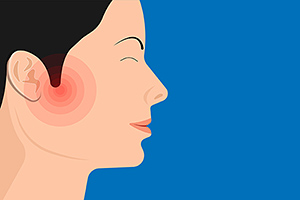After the diagnosis of temporomandibular disorders (TMD) into arthrogenic, myogenic or neurogenic classifications (as described in my December 2021 article, "Temporomandibular Disorders: Assessment and Classification") has been performed, then you need to choose the appropriate treatment.
Postural Correction
As far back as 2000, postural correction was found to be beneficial in the treatment of TMD. Komiyama (1999) found postural correction in ADLs to have a positive effect on TMD-associated myofascial pain with limited mouth opening. By combining posture training and TMD self-management, Wright (2000) found it to be more effective than self-management alone for myogenic TMD.
Clinical Tip: Old school still works! Start your TMD patients with postural correction to fix sagittal-plane alignment by reducing forward head posture and then assess frontal-plane alignment by maintaining the head, shoulders and hips level.
Layering Treatment
 A meta-analysis of TMD treatment by Armijo-Olivero in 2015 offers good insight into layering your TMD treatment for optimum effectiveness. Myofascial and arthrogenic TMD conditions benefit from manual soft-tissue work and exercise, both in-office and home based. The myofascial techniques utilized were numerous and included massage, post-isometric relaxation, ischemic compression, spray and stretch, and external and intraoral techniques.
A meta-analysis of TMD treatment by Armijo-Olivero in 2015 offers good insight into layering your TMD treatment for optimum effectiveness. Myofascial and arthrogenic TMD conditions benefit from manual soft-tissue work and exercise, both in-office and home based. The myofascial techniques utilized were numerous and included massage, post-isometric relaxation, ischemic compression, spray and stretch, and external and intraoral techniques.
When compared to self-management or exercise alone, the myofascial techniques combined with self-care cohorts all responded better. The studies that included manipulation and mobilization all indicated a better response.
Clinical Tip: Be proficient at treating the mastication muscles and associated trigger points, especially in the neck. Combine your myofascial release technique with home exercises, CMT and postural advice to get the best outcomes.
A more recent analysis by Li (2021) concurs that conservative treatment is indicated early in treatment since it is less likely to cause harm (allopathic conservative treatment also includes over-the-counter and prescribed pharmaceuticals). The next treatment provided, according to Li, is the addition of occlusal appliances. However, while multiple designs of appliances are available, Li states: "At present, there is no consensus on which design is superior." Patients with bruxing and clenching often need an appliance to offload the TMJ.
Obviously, if conservative measures fail, invasive procedures become an option for treatment. Currently, open joint surgery is rare and reserved for specific situations. However, minimally invasive procedures such as arthrocentesis (lavage of the TMJ with saline) or perhaps arthroscopic intervention can be considered. Arthrocentesis is considered a controversial procedure.
Modalities that have demonstrated positive outcomes in the literature for treating TMD include extracorporeal shockwave, ultrasound and photobiomodulation (PBM). Low-level pulsed ultrasound was successful at six months posttreatment in 97 percent of cases. Dry needling and acupuncture of the TMJ are promising; however, there is a lack of sufficiently sized studies for it to be strongly recommended.
Clinical Tip: Consider stacking modalities for TMD management. An inflamed, acute condition would prefer PBM w/counterirritant-free topicals, pulsed ultrasound, TECAR and myofascial release of distal trigger points. In the subacute to chronic stage, include local myofascial release, CMT and shockwave.
Active Care / Exercises
Active care and exercises for TMD can address tight and taut muscles, as well as the hypermobile TMJ. For chronically tight and shortened orofacial muscles, instruct the patient to place the tip of the tongue on the top of the palate, just behind the teeth, and hold with slight pressure for 10 minutes, three times/day.
To stabilize a hypermobile mandible, instruct the patient to place the tip of the tongue against the palate behind the teeth; slowly open the mouth; hold for two seconds; and repeat: 15 repetitions, 2-3 times/day.
To globally strengthen the mastication muscles, instruct the patient to open the mouth with slight overpressure, being sure to keep the mandible in the midline; and perform 15 repetitions, 2-3 times/day.
CMT of the TMJ
CMT of the temporomandibular joint is also appropriate. It is important to remember the mandible acts as a hinge joint, and both sides need to be addressed, especially if the patient has an arthrogenic TMD. Adjusting instruments can be effective on the area, as well as manual adjustments. A great video on CMT of the TMJ can be found here: www.youtube.com/watch?v=WL1YyHm9Yi8.
Clinical Tip: Cushioning the forces of the mandibular condyle against the temporal bone is a disc, held in place by small intradiscal ligaments. Be attentive not to overstress and stretch these ligaments with aggressive CMT, which will create a chronic hypermobility. Less aggressive CMT is better on the TMJ.
Clinical Pearls
TMD can lead to chronic pain and dysfunction. Asquini (2021) found chronic TMD sufferers were more susceptible to COVID-19 distress with deterioration of psychological status, worsening features of central sensitization and increased chronic facial pain severity. These patients would need psychological counseling to complement your modalities and manual therapeutics.
Treating TMD needs to be in every DC's wheelhouse, as conservative care is the treatment of choice. Start with modalities, myofascial work and postural correction, layering modalities based on the stage of healing and classification. Self-care instructions such as limited mouth opening, and avoiding chewing gum and foods difficult to chew, are also appropriate.
Resources
- Armijo-Olivo S, et al, Effectiveness of manual therapy and therapeutic exercise for temporomandibular disorders: systematic review and meta-analysis. Phys Ther, 2016 Jan;96(1):9-25.
- Ba S, et al. Ultrasound is effective to treat temporomandibular joint disorder. J Pain Res, 2021:14 1667-1673.
- Brochado FT, et al. Comparative effectiveness of photobiomodulation and manual therapy alone or combined in TMD patients: a randomized clinical trial. Braz Oral Res, 2018;32:e50.
- EspÃ-López GV, et al. Effect of manual therapy and splint therapy in people with temporomandibular disorders: a preliminary study. J Clin Med, 2020;9:2411.
- Fernández-de-las-Peñas C, Von Piekartz H, Clinical reasoning for the examination and physical therapy treatment of temporomandibular disorders (TMD): a narrative literature review. J Clin Med, 2020;9:3686.
- Jayaseelan DJ, Tow NS. Cervicothoracic junction thrust manipulation in the multimodal management of a patient with temporomandibular disorder. J Man Manip Ther, 2016; 24:90-97.
- Li DKS, et al. Temporomandibular disorders: current concepts and controversies in diagnosis and management. Diagnostics, 2021;11:459.
- van Grootel RJ, et al, Towards an optimal therapy strategy for myogenous TMD: physiotherapy compared with occlusal splint therapy in an RCT with therapy-and-patient-specific treatment. durations, BMC Musculoskel Dis, 2017;18:76.
- Wieckiewicz M, et al. Reported concepts for the treatment modalities and pain management of temporomandibular disorders. J Headache & Pain, 2015;16:106.
- Xu GZ et al. Low-level laser therapy for temporomandibular disorders: a systematic review with meta-analysis. Pain Res Management, 2018;2018:4230583.
Click here for more information about Donald DeFabio, DC, DACBSP, DABCO.





